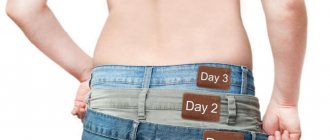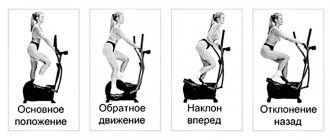Ask almost any amateur runner why he started running, and you will most likely get the answer that the first goal was to lose excess weight. The paradox is that the situation “I run but don’t lose weight” is very common. Running coach Ekaterina Preobrazhenskaya told why this annoying problem occurs and how to deal with it.
Running is one of the most energy-intensive types of physical activity; on average, you can burn about 500 kcal in an hour. It would seem, what could be better for weight loss? But there are a number of common misconceptions that stand in the way of achieving the desired goal.
I run a lot and I have a voracious appetite.
Weight loss comes not from exercise per se, but from a calorie deficit. If you run for an hour a day, but at the same time eat 500 kcal more than normal, you will not lose weight. Running is a good way to burn off calories, but to lose weight, you don't need to completely compensate for them with food.
I eat very little
Severe malnutrition puts the body under stress, and it begins to accumulate reserves at every opportunity and is reluctant to use them. Moreover, “hunger strikes”, as a rule, lead to overeating on certain days, and as a result, the entire “accumulated” calorie deficit is compensated by eating in one excessive meal.
I run fast, but there is no effect
During intense running, energy is produced primarily anaerobically (that is, oxygen-free) - this type of energy exchange involves glycogen, not fat. Of course, if you maintain a calorie deficit after such a run, this will contribute to weight loss, but you should not expect that increasing the intensity of the exercise will directly lead to weight loss.
50 developmental exercises for training at home
I focus on the number on the scale
Muscle is denser than fat tissue, which means it is heavier. With regular physical activity, muscles develop, so weight can increase. Body composition can change, but the number on the scale remains the same.
Running makes me gain weight quickly
This situation can happen, only weight gain occurs not due to the increase in adipose tissue, but due to the accumulation of water. Water is needed for muscle recovery and also for the absorption of nutrients. In addition, since the body loses a lot of fluid when running, it begins to store it for future use.
I run monotonously
The human body has an excellent ability to adapt to circumstances, and if the loads are monotonous and monotonous, eventually our body gets used to them, which subsequently negatively affects both athletic performance and the loss of extra pounds.
I want quick results
By weighing yourself every day, you're not really tracking fat gain or loss, but rather random variations in hydration levels. It's wiser to set long-term goals and expect gradual weight loss.
So, how to run and lose weight? Here are 4 basic rules of running for weight loss.
Maintain a calorie deficit
First, you need to understand that there is no “magic pill” for losing weight, and running cannot be one. Fat loss occurs due to a calorie deficit. A calorie deficit is a situation where the number of calories burned over a period of time (for example, a day) is greater than the number of calories eaten.
To lose half a kilo of fat, you need to “not eat” about 3500 kcal. Nutrition experts recommend keeping the difference between calories burned and consumed between 300 and 600 kcal per day (then, using simple math, losing one kilogram will take from 6 to 12 days). Such a deficiency does not put the body under stress, nor does it create an acute feeling of hunger, which can lead to overeating.
Does running in place help you lose weight?
Those who don't have enough time to go for a run in the park can exercise at home. And the same training is an excellent alternative when the weather is bad outside. There are several home exercise options.
Running in place
It is important to maintain proper running technique if you decide to do it on the spot. Relax your shoulders, bend your elbows, and pull your stomach in. While running, the back should remain straight, legs raised high from the floor, inhale through the nose, exhale through the mouth.
You can choose the intensity of such training yourself depending on your functional state. Running in place will help you lose weight in any case, only at different intensities the excess weight will come off at different speeds.
Treadmill
Few people have such a machine at home, but in winter, when the weather outside is not very good, many prefer treadmills in the gym to exercise in the fresh air. The good thing about the track is that on the screen you can see your speed, distance covered and other parameters. Some tracks will even show your current heart rate.
If you plan to only jog on the track in the gym, then you need to exercise for about an hour. But if you also plan to perform other exercises, then half an hour will be enough to start the fat burning process.
Climbing stairs
This run can also be considered running in place, because you are not moving much in space. This activity is considered more fat-burning if you maintain normal intensity. Therefore, half an hour is enough to burn about 800 kcal.
Please note that the main load will be on the muscles of the thighs and buttocks. The next day you may feel slight pain in these areas.
Running in the morning or evening is also a great anti-stress
Run at low intensity
Secondly, for optimal fat consumption during physical activity, it must occur in the aerobic zone, i.e. on the pulse, in which energy exchange occurs using oxygen, and the body uses fat for fuel. This is individual for each person, but, as a rule, this is a load below the aerobic threshold. This is often a low-intensity run where you can talk for more than 30 minutes.
You can find out your pulse thresholds and fat burning schedule by undergoing functional testing in the laboratory. There is no point in calculating pulse zones using the formulas that the Internet is teeming with - this is “the average temperature in the hospital,” nothing more. Your indicators may differ radically from the statistical average. Moreover, some people burn fat above the aerobic threshold.
Why combine 2 types of loads?
I’ll repeat myself a little, but these won’t be superfluous. Simply by burning fat, you can remain thin, without beautiful shapes; strength training with iron will help you create the body of Apollo and Aphrodite, because you will agree that a sculpted body looks much more beautiful.
If you just run, you will be left without muscles, and spending hours in the gym will make it difficult to get rid of large amounts of fat.
Combine strength training with aerobic training, eat right, lead an active lifestyle, use the steps instead of the escalator and elevator whenever possible, and your figure will thank you, good luck!
Alternate slow running with interval training
Thirdly, running at a “fat” pace should be alternated with interval training. This will prevent the body from getting used to the monotonous load, and will also develop muscles, which will lead to greater calorie consumption.
It is worth keeping in mind that during high-intensity training, it is not fats that are used, but glycogen, which is found in the muscles and liver. If you do not replenish its reserves after training (close the “carbohydrate window”), then glycogen will continue to be consumed for several hours, which will negatively affect recovery. Therefore, after such a workout, it is advisable to eat something light and carbohydrate-containing, for example, a green apple. However, there is no need to get carried away - since energy is expended and after such a workout, the fat burning process starts, and it is advisable to make the main meal mainly protein.
How to lose weight. Instructions for runners.
Conventional diet principles are of little use to runners. If you follow a regular diet, you will always be hungry and you will not have enough energy to exercise, and as a result... excess weight awaits you. That's why we took the 6 main principles of basic diets and adapted them to the needs of runners. We hope our tips will help you continue effective training, get stronger and lose 2-3 extra pounds.
Principle 1: Eat the right fats.
Regular Diet Strategy
: Limiting fat.
Runner Strategy
: consumption of the “right” fats.
Already in 2007, scientists proved that consumption of monounsaturated fats contributes to normalization and weight loss. Although fat hysteria peaked in the 1990s, many people trying to lose weight still try to limit their diets to vegetable oils, nuts, butter and other fats. It's logical. If you don't want to see excess fat on your body, don't eat it. Also, many people know that one gram of fat provides 9 calories, and 1 gram of carbohydrate provides only 4 calories. You can get the same amount of calories and still consume more food if you eat mostly carbohydrates and protein. But recently, researchers are coming to the conclusion that consuming fat is not so bad. Some studies have shown that consuming small amounts of fat promotes weight loss. The most important thing is to eat
Principle 1: Eat the right fats.
"correct" fats. Saturated or “trans” fats are unhealthy because they increase LDL (“bad cholesterol”) levels. These fats also reduce HDL (“good cholesterol”) levels. This increases the risk of heart disease, not to mention the harm of such fats for maintaining optimal weight. But mono- and polyunsaturated fats offer important health benefits. That's why they need to be included in the "runner's diet."
1.They fill you up quickly.
Polyunsaturated fats promote a feeling of fullness, reduce hunger levels and maintain blood sugar levels. This is important because if your sugar levels drop too low, you may feel food cravings, brain fog, overeating, low energy, and feeling weak and unable to stick to your diet.
2. Protect heart health.
Unlike trans fats, monounsaturated fats, which can be found in vegetable oils (olive oil, butter and canola oil) and avocados, help lower LDL levels, which reduces the risk of heart disease.
3. Reduce the risk of injury.
Unsaturated fats help reduce the risk of tears and fractures. In 2008, the Journal of the International Society of Sports Nutrition found that women on low-fat diets had more injuries and fractures—and if you stop training because of an injury, you quickly gain weight.
4. Reduce pain in ligaments.
Omega-3 fatty acids, such as those found in polyunsaturated fats, fish (salmon), nuts, and flaxseed oil, supply the body with anti-inflammatory elements that alleviate knee pain, back pain, ligaments and joints. Hence the result - less pain, faster recovery, more running.
Runner's commentary: Abi Meadows
37 years old, San Antonio, USA “I was an ultra marathon runner, and thanks to the high mileage I had no problems with weight. But after having 5 children, I gained 8 kg that I couldn’t lose. Restricting calories didn't help, I tried to exercise. I ran 160 km a week, burning up to 2000 calories a day. My nutritionist advised me to increase the proportion of fat in my diet. At first I doubted it (I only ate low-calorie cheeses and salad dressings). I added salmon, avocado, nuts, and flaxseed oil to the diet. The results were incredible: after 6 months, the weight was gone, I became more energetic, the craving for “snacks” like ice cream and chips decreased, and I no longer eat cakes and cakes “
Principle 2: Vary your workout routine with new types of exercise.
To lose weight, add alternative workouts.
The average person's strategy: develop a running training system and stick to it.
Principle 2: Vary your workout routine with new types of exercise.
Runner's strategy: Add new types of exercises and change schedules all the time.
Anyone who wants to lose weight understands that they must exercise almost every day, and this is difficult. So, to stay in shape, people trying to lose weight develop a workout routine (usually consisting of long, slow workouts) and stick to it no matter what happens. "People like to do what they can do," says Pete McCall, an exercise physiologist with the American Aerobics Association. “If you're a runner, you feel comfortable running a certain pace and a certain distance.” By following this regimen, you feel stable.
Of course, to control weight, it is better to run 5-6 km a day at a calm pace than to do nothing at all, but there is a more effective approach. You need to break up your routine and do different intensity workouts (such as short intervals or alternative training) to force your body to burn more calories. This is similar to an engine that burns more fuel during nervous city driving than on a smooth highway. When you run long, slow workouts, your body gets used to and adapts to the stress, burning calories more economically. The more times you run the same distance, the easier it becomes for you and the fewer calories you need to overcome it. Doing short sprints is like stopping your car all the time and starting again, which uses more fuel. And, it is very important that variety improves the psychological background of training.
Runner's Commentary: Buck Hales
55 years old, Oak Park, Illinois. I've been running marathons and ultra-marathons since 1991, but five years ago I had to cut back sharply due to a knee injury. Since I could no longer do even 60 km a week, I immediately gained 8 kg. I needed to maintain my aerobic endurance even though I couldn't run as much as I needed. So I started cycling to and from work five days a week. The extra pounds were gone in just 6 months. I still use the bike to supplement my running training, and in the winter I use the ski machine 3-4 times a week. I still run, but with breaks for alternative aerobic workouts.
So, vary your workouts.
A runner weighing approximately 70 kg doing 7 km at a pace of 5.30 minutes per km will burn approximately 480 calories per workout. But you can lose more calories and speed up your weight loss if you add something intense to your schedule.
METHOD:
Interval training
WHAT TO DO:
Do 400-meter sprints with recovery breaks.
FOR WHAT:
Sprinting at high speed forces your body to work harder and burns 30% more calories.
HOW:
4 x 400 meters at maximum speed, between them 400 meters - recovery slow run. 8 x 200 meters at maximum speed, breaks of 200 meters
4 x 100 meters at maximum speed, after the sprint, walk back to the starting point.
CALORIES:
700
METHOD:
Fartlek
WHAT TO DO:
These are the same intervals, only without clear rules on distances.
WHY:
Like interval training, fartlek increases the intensity of your calorie burn.
HOW:
When going out for a 45-minute run, spot an object about 50 meters from the start. Run to this object at the highest possible speed, then slow down and run calmly until your heart rhythm is restored, then accelerate again and recover again.
CALORIES:
540
METHOD:
Gorki
WHAT TO DO:
Run uphill and downhill
WHY:
Slides require a lot of effort to overcome gravity. The steeper the angle, the stronger the leg muscles work.
HOW:
Find a rise that is approximately 40-80 meters long. Run up and then down. Start with ten repetitions and then increase to twenty.
Run 5 times at 50% of your maximum intensity
2 or 3 times at 80% intensity
2 or 3 times at maximum speed
CALORIES:
600
Principle 3: Eat quality carbohydrates at every meal.
By choosing the right carbohydrates, you can reduce weight while increasing your performance.
The average person's strategy:
To lose weight, you need to reduce your carbohydrate intake.
Runner's strategy: Eat quality carbohydrates.
Over the past decades, diets such as the Atkins diet and other similar weight loss methods based on limiting carbohydrate intake have become very popular. It's clear why these
Principle 3: Eat quality carbohydrates at every meal.
theories are popular. Their essence is that if you consume only proteins and fats, the supply of sugar to the muscles will be reduced. Without receiving the necessary energy, the muscles will begin to use fat as fuel. However, runners have a different story. We need carbohydrates because they are the main source of glucose, the sugar that our brains and muscles use for fuel. Most glucose is stored in the muscles and liver as glycogen and is used during running. But the body can only store a limited amount of glycogen, so if we don't eat enough carbohydrates, we simply won't have enough to run.
By maintaining a high level of carbohydrates in your diet, you provide high energy levels, which help you progress in your workouts and therefore burn more calories during exercise and throughout the day. All this leads to higher levels of overall activity, higher calorie intake and, consequently, weight loss. You just have to remember the golden rule: “what kind of carbohydrates you consume is very important.” Here is a short overview on the topic of the “correct” carbohydrates and the “correct” time to consume them.
1. Slow burning carbohydrates:
These are carbohydrates that are high in fiber and digest slowly. They are able to keep your blood sugar level even, providing you with energy for a long period of time. They should be the basis of your diet. They can be obtained from cereals (rolled oats), whole grains, beans, lentils, fruits and vegetables.
2. Fast burning carbohydrates:
These are carbohydrates that are quickly digested, low in fiber, and have a rapid impact on blood sugar. They provide a quick burst of energy, which is useful for a runner before heading out to train, but they should be consumed with caution and moderation. They are found in pasta, white rice, white flour, potatoes and corn.
Runner's Commentary: Jessica Trumble
24 years old, Albuquerque, USA
“Several years ago, I was prescribed a medication that had side effects. I gained 8 kg. To lose weight, I cut down on almost all carbohydrates – bread, pasta, everything that is considered “bad” food. I managed to lose a few kilos, but I was always hungry, ate more candy, and became so weak that I had difficulty finishing a 7-kilometer workout. Then I gradually added whole grains to my diet, such as pita bread and whole grain muffins. Instantly my body responded positively to the influx of energy. Now I eat carbs in the morning because they give me energy for the day. I find it easier to run and my longer workouts help me lose weight.
Principle 4: Reduce your total calorie intake based on your lifestyle.
The smallest changes in diet lead to results.
The average person's strategy:
Reducing your calorie intake by 500 per day results in a weight loss of 300 grams per week.
Runner's strategy: Based on the number of calories burned while reducing the calories consumed.
Principle 4: Reduce your total calorie intake based on your lifestyle.
You may have heard this rule more than once: “reduce your intake by 500 calories a day and in a month you will lose a kilogram.” It's simple and clear. But for runners, especially those who train a lot, such drastic calorie cuts won't work. He simply will not be able to train at the proper level. Therefore, if you are in a training cycle, you should not drastically reduce the number of calories you consume. Here's how it's done.
1. Calorie counting:
For a week, keep a detailed diary of everything you eat, indicating portion sizes and the exact composition of the dishes. Also indicate your health and your feeling of hunger on a scale of 10 during the day. Then count the calories. Many websites provide detailed tables for calorie counting.
2. Cut back a little at a time:
Start cutting down 300 calories a day. This is a more realistic figure. Because you're running, it's easier to achieve a 500-calorie deficit.
3. Analyze the records:
If, after cutting 300 calories, your satiety level remains unchanged, and you feel normal, and your weight does not change, then you can cut more. But this must be done very gradually. In addition, you can add mileage, but also a little at a time. If you are training for a marathon, then look at the training weeks. For example, if you have a hard week with high mileage and high-speed training, you don’t need to cut calories, if, on the contrary, you have a week of rest, it makes sense to cut back on food. Everything is very connected and the success of your training depends on your attention to nutrition.
Small changes, big results.
You don't have to make dramatic dietary changes to cut a small number of calories. Here are small tricks that lead to great results.
Put away:
White bread with soft cheese for breakfast – 350 cal
Replacement:
Piece of whole grain bread with nut butter and small yogurt – 325 cal
Put away:
Coffee with milk (large Starbucks mug) – 190 cal
Replacement:
Same thing, but with skim milk - 130 cal
Put away:
Chocolate bar – 250 cal
Replacement:
Whole grain cereal bar - 180 cal
Put away:
Sandwich with meat, mayonnaise, cheese and vegetables - 400 cal
Replacement:
The same thing, but instead of mayonnaise, without cheese, more vegetables and apple slices - 340 cal
Put away:
Pork neck kebab and apple, nut and goat cheese salad - 485 cal
Replacement:
Pork Tenderloin Skewers, Remove Cheese from Salad and Add Cup of Brown Rice Instead - 380 cal
Put away:
Vanilla ice cream serving: 290 calories
Replacement:
Half serving of vanilla ice cream and berries - 205 calories
Total initial menu:
1.975 cal
Corrected menu:
1,560 cal
Saving:
415 cal
Principle 5: Eat natural foods.
Filling your plate with whole, natural foods can help improve your workout performance.
The average person's strategy:
There are special dietary meals.
Runner's strategy: eat natural foods.
For many people trying to lose weight, going to the store becomes torture. They are looking for products that will help them eat less and lose weight. They often choose products with labels that promise that the product is low in fat, has fewer calories, and helps you lose weight.
Principle 5: Eat natural foods.
or does not contain carbohydrates. People think that you have to eat certain diet foods to succeed in losing weight. But, as often happens, the opposite turns out to be true. Runners can lose weight by eating normal foods that taste better than diet foods and are more nutritious and beneficial to the body. It is much healthier to eat lean meat, vegetables, whole grains, nuts and seeds. Sometimes it seems like cooking with real ingredients takes more time than buying pre-made “low calorie” pizza. However, if you try to properly plan your weekly supply of food, then you will always have products ready from which you can quickly make something - healthy and tasty. Look for recipes for simple and healthy dishes.
Option of recipes for the whole day.
Many dietary dishes have an insufficient carbohydrate component. Try to provide yourself with carbohydrates at every meal. And then you will have a lot of energy and strength.
Breakfast:
Try mixing a banana, some honey in a blender, and sprinkle some nuts on top. You have a wonderful light dish ready for your first breakfast, after which you can safely go to training. After your workout, you can eat whole grain bread with nut butter or oatmeal.
Dinner:
To avoid overeating in the lunchroom at work or at a fast food restaurant, make yourself a chicken breast sandwich with mustard, herbs and cucumbers. As a snack, take peeled vegetables with you: carrots, celery stalks. Use nuts to fill you up between breakfast and lunch.
Dinner:
Fish with rice and broccoli is a wonderful, healthy dinner that contains carbohydrates, fiber and fatty acids.
Principle 6: Balance your running workouts with strength training.
Strength training helps you burn more calories and prevent injury.
The average person's strategy:
Avoid strength training to avoid bulking up and gaining muscle mass.
Runner's Strategy: Finding the right balance between running and strength training.
Principle 6: Balance your running workouts with strength training.
Many people avoid exercises with dumbbells and on machines, because they are afraid of pumping up and increasing in volume. Many people also know that an hour of aerobic training burns more calories than an hour on exercise machines. If you have a busy schedule, it seems smarter to spend an hour doing aerobic exercise. However, the truth is that adding a few strength training sessions per week will reap many benefits, including weight loss. Research has shown that strength training reduces body fat and helps you look leaner and leaner. Here's how it works.
1. Muscles consume more calories:
At rest, fat requires almost no calories, while muscles always consume oxygen. If you increase the percentage of muscle mass in your body, then you increase your body's ability to use oxygen, which requires calories. Your body typically burns between 4.5 and 7 calories per ounce of muscle mass per day. Thus, a 150-pound runner with 20 percent body fat, if he decides to reduce his body fat percentage by 5 percent, will burn an additional 36-56 calories at rest. Simply by increasing the % of muscle in your body, you turn into a calorie burning machine.
2. You will become more efficient:
Strength training will help you run faster, longer, and more efficiently. Those runners who additionally do strength training 3 times a week have stronger legs, this increases speed and endurance. Accordingly, the runner increases mileage, recovers faster, and becomes more efficient.
3. Your risk of injury will be reduced:
Strength training improves the condition of joints and pumps up those muscles that support ligaments. This way, you reduce the risk of injury, which means you can continue to train at a high level. Do squats, lunges, abdominal work and it will not only be easier for you to run, but also safer. Exercises for developing leg muscles are very useful. Especially those that strengthen the knees and hips - two of the most fragile areas for runners.
Runner's Commentary: Tom Parnell
34, Boston
“In 2007 I was running about 40 to 60 kilometers a week. Then I injured my ligament playing football and was out of training for 9 months. Lying on the couch, I gained 12 kg. Even without running, my knees started to hurt under the weight. Then I started working out in the gym 3 times a week. I was able to lose half of the weight I had gained and started running again with a more toned body. I became stronger, faster and this helped me avoid injuries in the future.”
Barriers in the fight against excess weight.
Is the scale needle still in place? Perhaps you are lost in three pines. Here's how to find the right path to your desired weight.
Deadlock #1: You're not getting enough sleep.
Studies have shown that lack of sleep leads to weight gain. The American Journal of Clinical Dietetics found that people who sleep less eat more snacks, especially high-calorie snacks. Lack of sleep leads to a drop in energy levels, and you unwittingly try to compensate for it by eating. Try going to bed earlier and waking up later.
Dead end #2: You eat junk food.
Hamburger is a heavy food. It has a lot of calories, more than vegetable soup or a turkey sandwich. Less heavy meals contain more water than fat and carbohydrates. They provide satiety with fewer calories. Those who eat heavy, trans-saturated fat foods have very little chance of maintaining a healthy weight. Filling themselves with such food, they consume less fruits and vegetables, which contain many useful microelements.
Deadlock #3: You eat foods that are the same color.
This interesting observation was made by US nutritionists and published in the journal Clinical Dietetics. Many runners eat mostly carbohydrates, with all their meals throughout the day consisting of light, pale-colored foods. The more colorful your plate, the more microelements and vitamins you get in one meal. Colorful foods fill you up faster and give you more energy, which in turn prevents you from overeating. Eat at least 5 flowers daily.
Deadlock #4: You're just running.
Running 25 kilometers a week burns about 1,500 calories, but to lose 1 pound of weight you need to burn 3,500 calories. Exit? Only running training in such a volume is not enough; at the same time, you need to reduce the number of calories consumed. If you add a 300 calorie reduction per day to this regimen, you will be able to reduce your body fat percentage by 25%.
Some tips for runners losing weight.
1. Maintain the routine:
Having lost weight, many return to old habits. If you decide to add calories, be sure to also add exercise, otherwise the weight will creep back on you.
2. Check your weight regularly:
People who weigh themselves frequently are more likely to lose weight and keep it off than those who don't watch the scale.
3. Try to find support:
Find like-minded people among runners, visit specialized sites, discuss your problems and achievements on forums, and share information. Openness and social activity helps not to focus on weight problems and stick to your plans and goals.
4. Don't eat due to stress and emotional difficulties:
You can’t eat out of boredom and/or a bad mood, control yourself. Food is your fuel, not your cure for stress. It’s better to go for a run; running is an excellent antidepressant. You should only eat when you are hungry. If a plate of steamed fish and boiled broccoli doesn't sound like an appealing meal to you, then you're not hungry and can save the chocolate for later.
5.Motivate yourself:
write a list of reasons why you want to lose weight. Hang it on the refrigerator and if the reasons are serious enough, it will be easy for you to follow the rules of proper nutrition.
Run occasionally on an empty stomach
Fourthly, the body will be especially active in using adipose tissue as a source of energy when running slowly on an empty stomach. The fact is that after sleep the level of glucose in the blood is low, and during low-intensity exercise the body will burn fat. This is especially effective if you did a strength workout the night before and your muscle glycogen stores are low. True, you should not get carried away with running on an empty stomach, so as not to get used to it - then the effect will decrease. Moreover, you should definitely drink a glass of water before such a run, which can last 30-40 minutes.
How to combine them?
The ideal option would be to space strength and aerobic training on different days, for example, training in the gym Monday - Wednesday - Friday, and leave running Tuesday-Thursday, Saturday and Sunday for the body to recover.
If time is short and an extra minute is like gold, then before strength training, set aside 5-10 minutes for running, and after training, run for 20-30 minutes and always remember, up to 20 minutes of running, excess water and carbohydrates leave the body in the form of sweat, fats are burned after a 20 minute run. Use interval running, for example jogging for 5 minutes, then a sharp acceleration for 30 seconds and again a calm pace for 5 minutes.
How long do I need to run before I start losing weight?
This is not a difficult question as many people think, and it can be answered with a little math. The matter can be complicated by numerous factors, among which is the individuality of each organism. But in general, you can rely on average statistical data.
Losing calories and weight
We know how many calories are burned when running. Of course, everything depends on the pace and intensity, but we are talking about beginner athletes, so the pace is assumed to be minimal, conversational.
In light of this, it is worth starting only from the weight of the future athlete, since the spread in calorie expenditure is quite noticeable. For example, an athlete weighing 70 kg will burn about 550-600 calories per hour of running, while someone weighing 85 kg will burn more than 700 calories.
From the example described above, it is clear that it is optimal to carry out calculations based on the fact that 8 calories per kilogram of weight .
But this does not give us a clear idea of the kilograms lost. In this case, you can again rely on average statistical data. In order to lose 450 grams of weight , you need to spend 3500 calories.
Probably someone will want to demand that all this data be converted into distance. This is also possible, although very roughly. To lose 2 kg of weight, you will have to run from 170 to 250 kilometers. Why such a spread? As usual, due to many minor conditions.
It is worth understanding that technically you will lose these kilograms, but in fact you will need fuel to overcome any distance, so the incoming food will always offset this result in the short term.
Adaptation
It's often overlooked, but you can't put on your running shoes and run a marathon tomorrow without training. That is, such a possibility exists, of course, but it borders on madness.
As the body adapts to the innovations and the body begins to strengthen, favorable changes will occur for the runner and undesirable ones for those wishing to lose weight.
Buy a sports bra
Exercising in a loose, too tight bra or without one at all is equally harmful to your breasts. In the first case, this threatens sagging of the mammary glands, and in the second - circulatory disorders.
You should also know that Cooper's ligaments are very thin and can easily become stretched during intense fitness activities. Excessively active physical sports accelerate the wear and tear of breast connective tissue. What should you do to prevent your breasts from sagging in this case? – To maintain its elasticity during active movements, the mammary glands must be well fixed. You can easily achieve this with the help of a special bra or a tight sports top, which securely fixes the breasts and prevents them from moving and sagging during exercise.
You can purchase a high-quality sports top at a competitive price or CLICK THE PICTURE
.
What is excess weight
First, let's define what excess weight is. If you follow the guidelines of the World Health Organization (WHO), then a body mass index of 24.9 is normal weight. If this indicator is higher, then we are talking about different degrees of excess body weight.
People who fall into these categories usually find it especially difficult to start exercising, if only because physical activity requires a lot of effort, and their usual lifestyle is often inactive. However, there are many examples of how obese people radically changed their lives and subsequently became marathon or Ironman runners. Therefore, nothing is impossible, the only question is how to approach the task of improving physical fitness correctly.
If you are overweight and want to start running, pay attention to a number of rules and tips.
Don't Miss: The Complete Beginner's Guide to Running
Running workout tables for losing weight
This is the case when they try to bring all the newbies to running under one brush. No valid tables can exist because the initial conditions are too different. Or there should be many similar weight loss tables to take into account every nuance and physical data.
You can focus on a weekly running training plan for beginners , when the condition of an average person of average activity is taken into account:
- Mon. Rotation exercises, warm-up walk 1 km, very easy run 30 sec
- VT. Rest
- SR. Rotation exercises, warm-up walk 1 km, light jogging 1 min, light stretching
- Thurs. Rest
- PT. Rotation exercises, warm-up walking 1 km, easy running 1 min, light stretching exercises
- SB. Rest
- Sun. Special running exercises, massage
- Mon. Rest
But, as you understand, there will probably be people for whom 1 minute of running will seem like a whole marathon. Huge body weight can also be the most noticeable and dangerous obstacle. In this case, the plan for the first week of running should be even softer. The first workouts are the time when maximum caution is required in increasing the load.
Is it possible to enlarge breasts with the help of fitness?
No you can not. The breasts are the mammary glands and the fat surrounding them, and the pectoral muscles, the growth of which is observed during fitness activities
, are under them.
That is, to enlarge the breasts,
you need to either achieve growth of the mammary glands (which means pregnancy), or increase the fat layer throughout the body. Both options look very doubtful.
However, with the help of sports you can improve your bust shape
, making it fit and slightly lifting it visually. However, you should not expect dramatic changes in appearance.
Running technique is the foundation
In the vast majority of cases, running techniques are not learned immediately. This usually requires first getting injured or starting to feel discomfort as your average training distance increases.
No one talks about perfect mastery of marathon technique. Moreover, such a thing does not exist. But you need to at least know the general principles and study your own body biomechanics. Then you subconsciously minimize the possibility of fatigue injuries, including stress compression fractures.
The problem with the initial lack of optimization of running movements and work on foot placement is that further retraining becomes more difficult. The power of habit is strong, which is why many amateurs continue to run marathons and get injured regularly. Most of them are saved from serious consequences only by long-term running activity and many years of adaptation of the musculoskeletal system. However, this may not work for everyone.
Another reason to immediately learn proper running technique is that you can begin to enjoy the movement after a short time. An old study found that runner's euphoria is much more likely to occur to those athletes who run more correctly, gently and rationally. Unfortunately, this statement can only be supported by personal observation. Could not find any source links.
How to tighten your pectoral muscles
We already know that the chest has a ligamentous apparatus. And they also have a muscle at their core. There is an opinion that breasts can be pumped up. In theory, this sounds very good for advertising campaigns for sports training, gyms or exercise equipment. Practically - in fact, it is possible, but the pectoral muscle occupies a very small percentage of the entire chest area, so even if it increases significantly, the effect will be difficult to notice.
In general, the breast does not consist of muscles, but of glandular and fatty tissue. Therefore, rest assured that playing sports will not help to enlarge your breasts, but may speed up their sagging, so be sure to buy sports underwear.
How to maintain the shape and size of your breasts?
If during training your legs, buttocks and stomach lose weight, this will inevitably affect your chest - this is a feature of the structure of the female body. With a large bust size, jumping and running are contraindicated, so it is better to give preference to strength training.
- Be sure to invest in a sports bra
that helps support your breasts during intense physical activity and allows you to maintain the same shape of your breasts. - It is prohibited to use express diets and fasting days.
Why? – Such dietary restrictions negatively affect the elasticity of connective tissues. It’s enough just to give up baking and sweets. At the same time, the skin receives all the necessary nutrients, and the breasts remain the same size. - Protein foods
are an excellent stimulant for collagen production. Its consumption not only strengthens muscles, but also increases the elasticity of connective tissues, which is of particular importance for maintaining the shape and size of the breasts. - Consuming protein shakes
also promotes the synthesis of collagen fibers.
To reduce the likelihood of breast shrinkage during training, take care in advance of a balanced diet, moisturizing creams with vitamins, a contrast shower, massage, and, of course, a set of exercises to strengthen the chest muscles. This is not all that needs to be done to prevent sagging breasts, but this will be quite enough.
Many women are extremely dissatisfied not only with the size of their breasts, but also with their shape. Absolutely everyone dreams of a beautiful bust, and if in their youth many are content with their parameters, then after childbirth everything changes dramatically and the thoughts of women are filled with questions about what to do to restore the former beauty of the mammary glands.
It is no secret that plastic surgery can not only restore, but also “add” what is missing. But such a procedure is not affordable for everyone, and the consequences that you may encounter also discourage you from carrying out the operation.
If your breasts have begun to sag and are not at all happy with their shape, then it’s time to go in for sports. It is active training that will allow you to tighten your breasts and wear revealing outfits without hesitation. In addition, you will have the opportunity to become the owner of an amazingly toned body, which will return you to an excellent mood and self-confidence. So, dear ladies, if you want to tighten your breasts, then let's start playing sports.
There are two options through which you can restore your bust’s elasticity, attractiveness, and even tighten it significantly. These include home workouts and visits to the gym.
In our article we will consider both options for dealing with the problem, which will allow you to choose the most suitable and convenient one.











